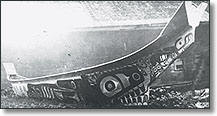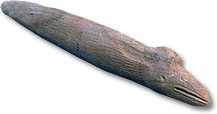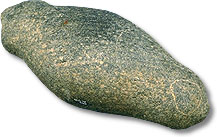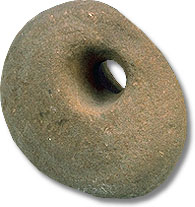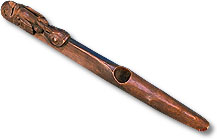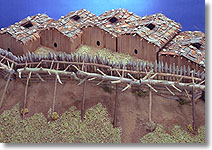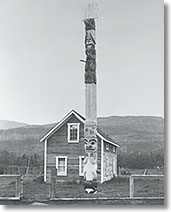WARFARE WARFARE THERE WERE A VARIETY OF REASONS THAT
146 TURCHIN KOROTAYEV POPULATION DYNAMICS AND INTERNAL WARFARE212 EXPOSURE TO BIOLOGICAL AGENTS TYPES OF BIOLOGICAL WARFARE
37 WARFARE IN THE 1860S 6 OF 6 A
449 ECONOMIC WARFARE – TOTAL WAR 449 ECONOMIC WARFARE
56 KOROTAYEV TRADE AND WARFARE IN CROSSCULTURAL PERSPECTIVE
ADVANCES IN NETWORKCENTRIC WARFARE AND SURVEILLANCE DENSELY DISTRIBUTED RFLINKED
WARFARE,
WARFARE,
|
WARFARE There were a variety of reasons that tribes clashed from time to time. Much like all cultures since the beginning of time, disagreements over territory, stores of food, ritual privileges all combined to cause the occasional war. The Pacific Northwest coast was particularly sensitive to righting past wrongs, and so the taking of slaves because part of the mix as well. The term "Warfare" is a bit of misnomer. There never was all out full-scale warfare but more a series of skirmishes and raids. Just as serious they caused loss of life and the taking of slaves, among other things. The Tsimshian were always on alert for raids from interior tribes who were driven by hunger. Also, the Haida and the Tlingit also routinely tried to raid Tsimshian trading routes, for example.
D Drawing is of a warrior, by Tsimshian artist Fred Alexcee, based on his memories of battles at Fort Simpson. The warrior is wearing leather armour and using a bow and arrows.
A
Warriors
wore 'armour' made from dried animal hide smeared with pitch to
make it as hard as
There
were also elaborate carved war canoes, Nothing like showing up to skirmish in style! The canoes were huge as you can see, some of which could carry up to fifty warriors and all their gear.
\ |
Tsimshian Society and CultureWarfareInstruments of WarInstruments of war included bows and arrows, spears, daggers, clubs, fist clubs, canoe breakers, and atlatls (boards that add propulsive force in throwing a spear).
|
|
|
Daggers
|
|
|
Clubs
|
|
|
Fist Clubs
|
|
|
Canoe Breakers
|
|
|
Atlatls
|
||
|
|
Warfare
War Canoes
|
War
canoe, Kitwancool. |
The Coast Tsimshian went to war in large,
seagoing canoes that could carry up to 50 warriors. Campaign supplies
were stored in the canoes, so that there was no need to stop for
food. The canoes were 12 to 15 metres long and about 2 metres across
at the beam. All canoes had a name, and were painted with crest
designs. After contact with European sailing ships, masts and sails
were also added to the large canoes.
Warfare
Fortification
Raids by small groups of tribes from the interior driven by hunger posed a constant threat to the Tsimshian, as did major, but infrequent, raids by Haida and Tlingit from their islands to the west and north.
|
Model
of Kitwanga Fort, by Arthur Price and Dr. G.F. MacDonald. |
Tsimshian men built fort-like enclosures to
protect their clans during times of invasion. The original Kitwanga
Fort was built by the ancient warrior,
Nekt, on a hill about 3 km north of the present village of Kitwanga.
Nekt was a highly feared warrior who led raids against villages on
the coast and on the Nass River. To defend against enemy raids, a
fence of spiked logs was built around the five houses of his tribe.
The logs could be released to roll down onto the invaders. The
"man-crushing log" became a crest that was put on totem
poles by some Kitwanga and Gitsegyukla families.
Tsimshian Society and Culture
Warfare
The Warrior
W
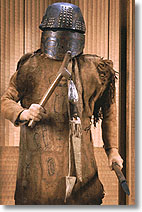 arriors
before 1830 (when muskets were introduced) wore protective clothing
when going into battle. Leather jackets and tunics made of sea-lion
or bear skin protected their bodies, while helmets and visors made of
wood protected their heads and necks. These items of clothing were
usually decorated with crest images that identified their owner's
clan affiliation.
arriors
before 1830 (when muskets were introduced) wore protective clothing
when going into battle. Leather jackets and tunics made of sea-lion
or bear skin protected their bodies, while helmets and visors made of
wood protected their heads and necks. These items of clothing were
usually decorated with crest images that identified their owner's
clan affiliation.
The warrior
Nekt fashioned himself a suit of armour made of grizzly-bear skin
lined with pitch and slate. During raids, his enemies mistook him for
the mythical Grizzly Bear, who was invincible because of his
impenetrable armour and his magical war club called "Strike Only
Once". The story of Nekt and his fort is often portrayed in art.
Today, many Nisga'a and Gitksan still claim him as their illustrious
ancestor.
|
Man-crushing
log-pole, portraying Nekt and his trophies. |
CHEMICAL WARFARE IN WORLD WAR I A MULTIGENRE ANALYSIS
CIVIL WARFARE … OR WHY CROMWELL WON ARMY COMMANDERS
CLASS WARFARE CLASSES VS PROTOTYPES BRIAN FOOTE DEPT
Tags: warfare there, ============================= warfare, warfare, variety, reasons, there
- IOWA DEPARTMENT OF NATURAL RESOURCES WATER LINE UTILITY COMPANY
- !doctype Html html Langen Classssc Public Fullscreen Home Mobilefriendly
- ANSUCHEN UM ORDENTLICHEN URLAUB DOMANDA DI CONGEDO ORDINARIO DIEDER
- INS ANGELETA FERRER I SENSAT LLISTAT DE LLIBRES
- COMMON SOLE (RESTRICTION ON FISHING IN THE IRISH SEA)
- BOTTOM OF FORM CISCO PRESENCE INTEGRATION WITH CCM 7X
- THE PHENOMENON OF THE ADVERSE MARKET REACTION TO DIVIDEND
- REGISTAR GOSPODARSTVENIKA HRVATSKE ZAJEDNICE U REPUBLICI SRBIJI UPISNICA
- STAT 211 HANDOUT 4 (CHAPTER 4) CONTINUOUS RANDOM
- НОВГОРОДСКАЯ ОБЛАСТЬ АДМИНИСТРАЦИЯ БЕРЕЗОВИКСКОГО СЕЛЬСКОГО ПОСЕЛЕНИЯ ОКУЛОВСКОГО МУНИЦИПАЛЬНОГО РАЙОНА
- DICHIARAZIONE SOSTITUTIVA DI POSSESSO DEI REQUISITI ART 38 DLGS
- OPĆE UPUTE ZA PRIPREMU BOLESNIKA PRIJE UZIMANJA UZORKA
- COMPARE & CONTRAST GRAPHIC ORGANIZER (THIS WILL BECOME YOUR
- 1 HALLAR EL RESTO DE DIVIDIR A) 1
- ANKIETA ANONIMOWA DOTYCZĄCA CHĘCI UCZESTNICTWA W KURSACH ZAWODOWYCH
- BESLUTNINGSPROTOKOL D IANALUND VANDVÆRK BESTYRELSESMØDE TORSDAG DEN 21
- PRIMEUR MAKELPUNT VOOR HUISVESTING MAATSCHAPPELIJKE ACTIVITEITEN OP 1 JANUARI
- PACIFIC ISLANDS POLYNESIAN ATTITUDES TO CHILD TRAINING AND DISCIPLINE
- VLADA REPUBLIKE HRVATSKE ZAGREB 14 LISTOPADA 2021 PREDLAGATELJ
- ANEXO I SOLICITUD DE PARTICIPACIÓN DATOS DEL CENTRO NOMBRE
- VEILEDER FOR KOMMUNALE TILSYNSMYNDIGHETER SOM UTFØRER TILSYN MED ASYLMOTTAK
- JULIA GARCÍA GONZÁLEZ 14 AÑOS
- ISDA DF PROTOCOL EXTENSION EMIR PORTFOLIO RECONCILIATION DISPUTE RESOLUTION
- INDSTILLINGSSKEMA UNDERVISNINGSTILBUD I NORDDJURS KOMMUNE FOR BØRNUNGE MED OPHOLD
- C PATIENT ID NO OMMUNITY PHARMACY MEDICINES USE REVIEW
- HONORS PHYSICS D UNIT 3 VECTORS AY 1 INTRO
- NORA SENI PROFESSEURE DES UNIVERSITÉS COORDONNÉES PROFESSIONNELLES PROFESSEURE À
- GİRİŞİMCİLİK DESTEK PROGRAMI UYGULAMALI GİRİŞİMCİLİK EĞİTİMİ EĞİTMEN BİLGİ FORMU
- STRATEGIC PLAN 2019 TO 2024 EXCELLENCE IN EDUCATION
- SMLOUVA O POSKYTNUTÍ SLUŽEB S NÁZVEM „ZAJIŠTĚNÍ
WYKAZ PODRĘCZNIKÓW MATERIAŁÓW EDUKACYJNYCH I MATERIAŁÓW ĆWICZENIOWYCH OBOWIĄZUJĄCYCH W
INSTRUKCJA WYPEŁNIANIA SPRAWOZDANIA WYNIKÓW Z STUDENCKIEJ OCENY NAUCZYCIELA AKADEMICKIEGO
 REQUEST FOR PROPOSAL IN SUPPLY OF MEDICAL SUPPLIES AND
REQUEST FOR PROPOSAL IN SUPPLY OF MEDICAL SUPPLIES AND A RTIFICIAL TURF FIELD RENTAL APPLICATION EAST GREENBUSH CENTRAL
A RTIFICIAL TURF FIELD RENTAL APPLICATION EAST GREENBUSH CENTRALREVISED 22497 REASONABLE DOUBT THE PROSECUTION MUST PROVE ITS
 INDOCHINA SEMINAR PAPER ON AUDITING STANDARDS GOVERNMENT BUDGET AND
INDOCHINA SEMINAR PAPER ON AUDITING STANDARDS GOVERNMENT BUDGET ANDANEXA LA HOTARAREA CONSILIULUI BURSEI NR 2908042008 PROCEDURA PRIVIND
14 PAPER PRESENTED AT SYMPOSIUM “BUILDING TRUST TOGETHER” OTTAWA
ANEXA LA HOTARAEA NR A CONSILILUI JUDETEAN HUNEDOARA CONSILIUL
E D P EQUITABLE DISTRIBUTION PROGRAM UTILIZATION
STATE OF INDIANA DEPARTMENT OF INSURANCE NOTICE OF PUBLIC
 DECLARATION FOR A CLUB PREMISES CERTIFICATE TO BE GRANTED
DECLARATION FOR A CLUB PREMISES CERTIFICATE TO BE GRANTED UNIVERSIDAD DE COSTA RICA CENTRO DE INFORMÁTICA
UNIVERSIDAD DE COSTA RICA CENTRO DE INFORMÁTICA POROČILO O IZVAJANJU ZDIJZ V LETU 2007 ORGAN OBČINA
SPRAWOZDANIE Z REALIZACJI ZADAŃ Z ZAKRESU REHABILITACJI SPOŁECZNEJ I
 131313 AVGIFTER VÅRD OCH OMSORG GÄLLER FRÅN OCH
131313 AVGIFTER VÅRD OCH OMSORG GÄLLER FRÅN OCHPUBLICADO EN EL DIARIO OFICIAL DE LA FEDERACIÓN EL
 AN APPLICATION OF REACHABLE SET ANALYSIS IN POWER SYSTEM
AN APPLICATION OF REACHABLE SET ANALYSIS IN POWER SYSTEMFALL 2011 GRADUATE ASSISTANT ATHLETIC TRAINER SCHEDULE UWA ATHLETIC
 OBRAZAC CRNA GORA MINISTARSTVO POLJOPRIVREDE I RURALNOG RAZVOJA DNEVNIK
OBRAZAC CRNA GORA MINISTARSTVO POLJOPRIVREDE I RURALNOG RAZVOJA DNEVNIK
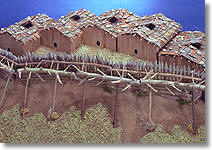 uring
the times of invasions much like the Haudensaunne who built
fortess-like palisades around their communities, Tsimshian men
also built enclosures to protect their families. The Tsimshian
were more creative however, and warriors such as Nekt, a highly
feared Kitwanga warrior built spiked palisades around his houses.
At opportune moments these logs would be released to roll down
and crush the enemy. Ouch! That has to smart!
uring
the times of invasions much like the Haudensaunne who built
fortess-like palisades around their communities, Tsimshian men
also built enclosures to protect their families. The Tsimshian
were more creative however, and warriors such as Nekt, a highly
feared Kitwanga warrior built spiked palisades around his houses.
At opportune moments these logs would be released to roll down
and crush the enemy. Ouch! That has to smart! s
noted, at times raids were intense, particularly after European
contact because of increased competition over trade routes;
Raiding was commonplace and frequently were in the form of
revenge responses to insults or injury, or to take slaves.
Pacific Northwest coast tribes were very sensitive in this
regard. Shaming was often used in the form of carving
'Shaming Totem Poles' or hold a 'shaming feast'.
s
noted, at times raids were intense, particularly after European
contact because of increased competition over trade routes;
Raiding was commonplace and frequently were in the form of
revenge responses to insults or injury, or to take slaves.
Pacific Northwest coast tribes were very sensitive in this
regard. Shaming was often used in the form of carving
'Shaming Totem Poles' or hold a 'shaming feast'.  rock.
Post-European contact saw the acquisition of metal, and so
headpieces that covered the face were also fashioned. Upon first
glance the clothing looks like it is straight out of the middle
ages, doesn't it?
rock.
Post-European contact saw the acquisition of metal, and so
headpieces that covered the face were also fashioned. Upon first
glance the clothing looks like it is straight out of the middle
ages, doesn't it?